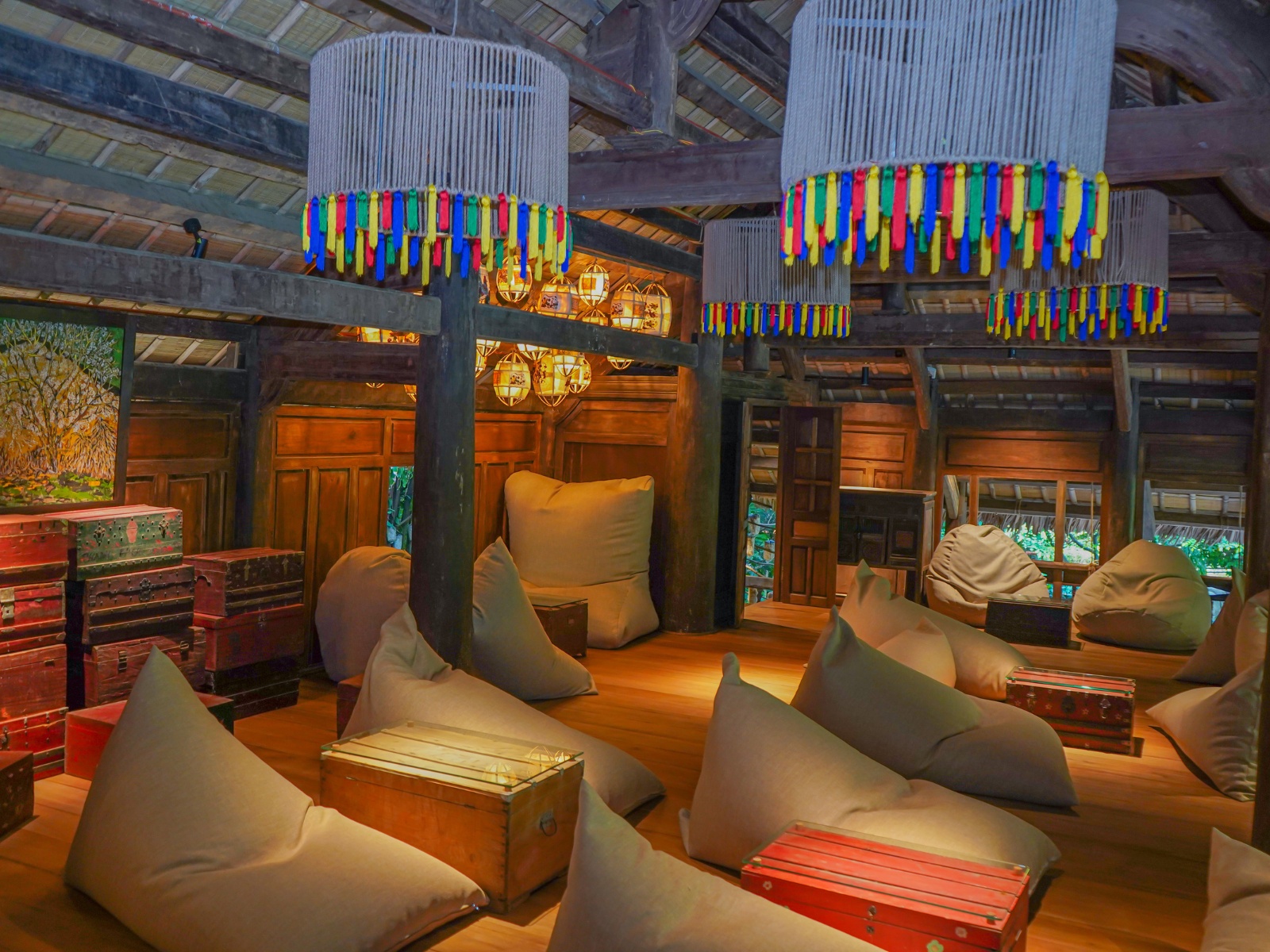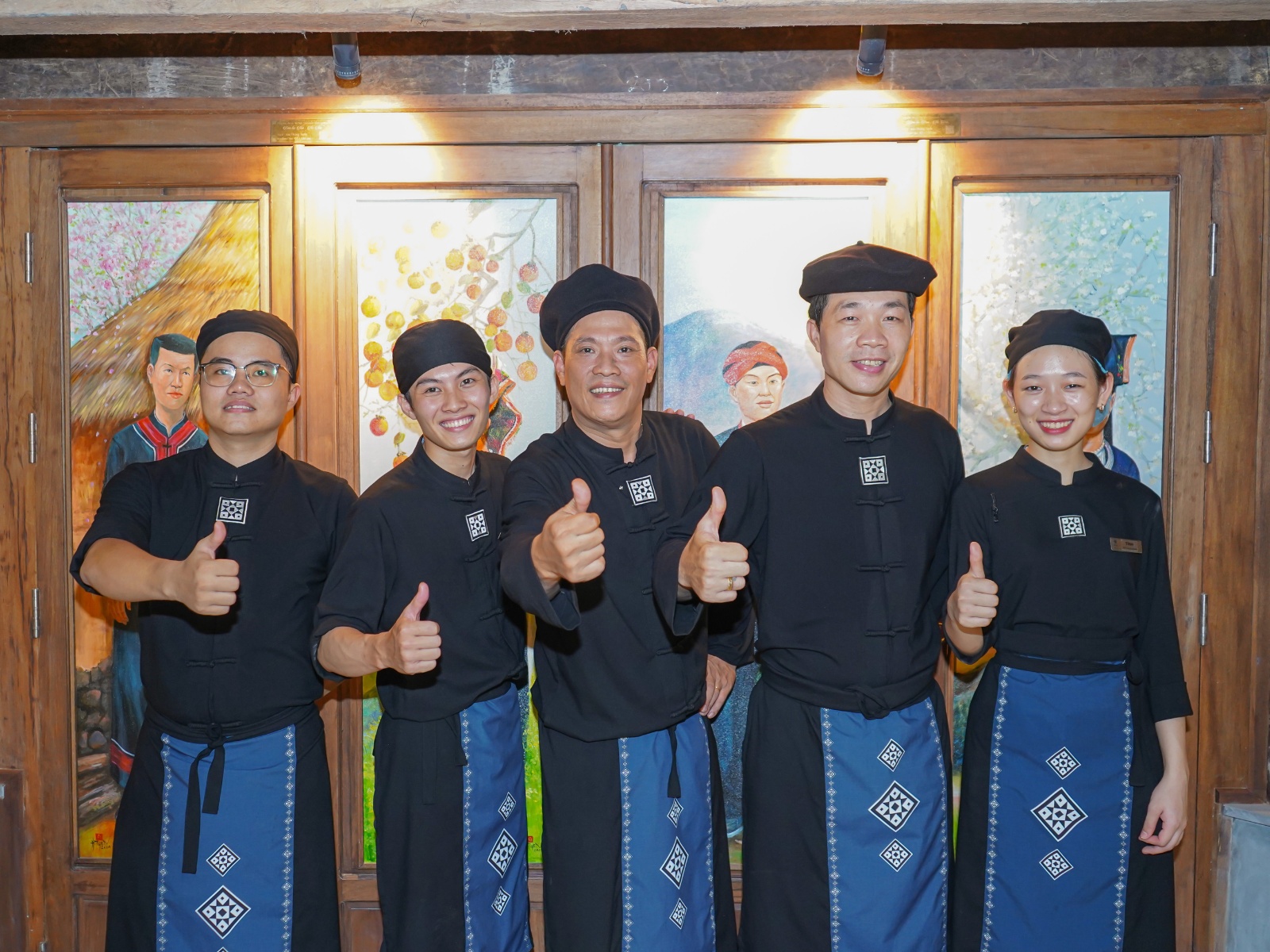
THE STORY OF A HERITAGE JOURNEY
“We named the project Tàya House because Tàya is inspired by the name of the Northwest region “Tây Bắc”, an area famous for its diverse ethnic cultures and majestic natural landscapes. Tàya House embodies the beauty and spirit of the Northwest region, where the traditional cultural values of ethnic minorities are preserved and promoted. The name Tàya is to remind us of the Northwest land, where every house, every structure is part of a rich, colorful cultural and historical story”

Mr. NGUYEN DUC QUYNH
General Director of Indichina JSC shared
(Furama Resort Danang)
From the Land of Stones to the city of the sea
Nestled peacefully under the lush green canopy of the Lagoon Garden at Furama Resort Danang, known as the “Green Island in the heart of the city”, Tàya House whispers and tells travelers from near and far the intriguing story of its life journey, from Muong Khu – the Land of Stones to Danang – the City of the Blue Sea.
The mission of preserving and conserving culture
Tàya House rests peacefully under the verdant foliage of the Lagoon Garden, once likened by famous writer Vu Tu Nam to a North Vietnamese forest – with rivers, streams, large and small rock formations, and winding paths. The Tàya House project is an initiative aimed at reviving and preserving the national cultural values by recreating the traditional stilt houses of the Vietnamese mountainous ethnic groups, led by Mr. Nguyen Duc Quynh – General Director of Indochina Joint Stock Company, the managing unit of the Ariyana – Furama International Tourism Complex.
“We named the project Tàya House because Tàya is inspired by the name of the Northwest region “Tây Bắc”, an area famous for its diverse ethnic cultures and majestic natural landscapes. Tàya House embodies the beauty and spirit of the Northwest region, where the traditional cultural values of ethnic minorities are preserved and promoted. The name Tàya is to remind us of the Northwest land, where every house, every structure is part of a rich, colorful cultural and historical story.…” Mr. Nguyen Duc Quynh shared.
The traditional stilt house of the Muong people
After more than a year of searching and selection, the project team of Furama Resort Danang has reviewed many stilt houses from different regions from the Northeast to the Northwest of Vietnam… Finally, a stilt house of the Muong ethnic group in Hoa Binh was selected as it fully met the criteria of cultural, legal, aesthetic and technical factors. To verify the information and ensure accuracy. Mг. Quynh sent a team of three people including Mг. Dang Ngoc Minh Trung – a wood expert, and senior advisor of the Project, Mr. Hoang Viet Hai – a senior construction specialist, and Ms. Bui Thi Le Thuyen – the legal director of Furama Resort Danang, who is also passionate about exploring the customs and practices of Vietnamese ethnic groups, to carry out the necessary procedures on site.
The architecture of the house includes three compartments and two wings, with a roof thatched with palm leaves and an open design that creates a connection and closeness with nature. It is mainly made of bamboo and Sèn wood, which are good quality and durable wood types that are highly appreciated in the traditional house building culture of the Muong people. The construction technique is entirely traditional handicraft with simple woodworking tools such as axes, chisels, saws, and planes. The structural components are sawn straight, carved, planed flat, mortised and assembled in an interconnected manner. In positions like stairs and floorboards, the surfaces are planed smoothly for convenience, while in other positions like column and beam trunks, they are only roughly squared or carved.
In Hoa Binh, to build their own stilt house, the ethnic people must go deep into the forest, fell trees by hand, and transport the heavy wood blocks weighing several quintals back to their village, entirely by human strength, accumulated over many years. The Taya House strongly reflects the unique architectural cultural features of the Muong ethnic group, along with nearly 50 years of its own historical story.
More than just a stilt house
According to the story shared by the homeowners around the crackling fireplace after the evening meal hosted for guests, the Taya House is the culmination of love, perseverance and the determination to build a cozy home, by Mr. Bùi Văn Minh and Mrs. Bùi Thị Nhàm thirty years ago. The husband reminisces, “the two of us came together through a family arranged marriage, when the bride was just coming of age and the groom was in his early twenties, According to the Muong people’s customs back then, the bride was only allowed to stay at her husband’s family home about three days a week, the remaining time she had to go back to her own parents’ house until she came of age by local standards or conceived her first child, only then could she permanently live with her husband’s family. Living in the extended family, the two of us yearned to build our own private home and the dream of a stilt house built by our own hands had constantly driven us to work tirelessly to make it a reality.”
The house construction began in 2002, when the young couple had saved up enough timber needed for the building. After a prolonged period of assembly with the help of the entire village, as per the Muong cultural tradition of “one household builds, the whole village comes to help”, the house was finally completed. The finished house, along with the birth of their four children (three sons and a daughter), made the young couple’s home complete, and each child brought along hope and happiness for the future. It can be said that the house is not just a living space, but also a symbol of the couple’s bond and love, the community’s unity, and the determination to preserve the cultural values of the Muong people across generations.
“The precious item has found its worthy keeper”
In the Muong Khu region the land of stones, when deciding to build a new concrete house to better suit the living needs and modern lifestyle as desired by their children, the homeowners were determined to find the most suitable place to entrust the family heirloom. The place chosen by the horneowners to transfer the house had to be one that understands, appreciates and preserves the cultural and spiritual values that the house represents. When meeting the representatives of the Taya House Project, learning about Furama Resort Danang – a resort with a special focus on conserving and promoting the national cultural heritage, the homeowners agreed to “entrust the gold” to Furama Resort Danang. The homeowners’ decision to pass on the house to Furama Resort Danang not only ensures the careful restoration and preservation of the house, but also the conservation and strong dissemination of the precious cultural and spiritual values contained in every detail of the house to the community. Thanks to this auspicious connection, Taya House has found its way to Furama Resort. Danang, just as the old saying goes “the precious item has found its worthy keeper”.
Journey to the coastal city
The journey to receive and reconstruct the house was an inspiring and meticulous process. In the final days of 2023. representatives of the Taya House Project braved distant mountain roads and challenging travel conditions in the cold weather of the highlands of Hòa Bình to bring a precious part of this cultural heritage back to Da Nang. Each detail of the house was carefully dismantled by local experts under the strict supervision of the project representatives to ensure that all components of the house remained intact for the reconstruction process. Every small detail of the house was clearly and systematically marked according to the traditional construction methods of the Muong people, carefully dismantled and loaded onto transport vehicles. Within a week, all components of the house were dismantled and transported intact from Hòa Bình to Da Nang.
During their stay and work in the local area, the project representatives had the opportunity to engage in friendly conversations with the
homeowners and residents. By the fireplace. the homeowner slowly shared memories associated with the house over the past decades. Through each heartfelt story, the guests could feel the homeowner’s bittersweet emotions as they parted with the house and understood the homeowner’s wishes for the house’s future. The moment they saw the teary eyes of the homeowner watching the truck slowly drive the house towards the coastal city, everyone in the project team knew exactly how they needed to treat the house to honor the homeowner’s sentiment.
After many months of meticulous construction with detailed advice from two local Muong artisans, Bùi Văn Quyến and Bùi Văn Nhu, who were invited to Da Nang to assist with the construction, the house was nearly fully reconstructed in the Lagoon Garden area of Furama Resort Da Nang. The house was built with its back against a high slope, facing a clear pool and surrounded by small flowing streams. The space around the house not only recreated the traditional living environment of the Muong people but also created a peaceful, poetic scene where the house seemed to be reborn, living again with its story and spirit. Reconstructed in such an environment, Taya House seemed as if it had never left its original land. Day by day. Taya House still retains its tranquil appearance under the ancient trees, quietly listening to the gentle conversations and whispers of the surrounding nature.
Besides the faithful reconstruction of the house, Taya House also displays many items associated with the daily life of the northern highland ethnic people, such as wooden chests wedding gifts for newlyweds, hanging lamps of the people, etc. Especially, through the skilled hands of artist Hoàng Tuyến, who specializes in paintings about Vietnamese communities and ethnic groups. the traditional costumes of the northwestern ethnic groups including Tây, Thái, Dao, H’mông, Mường, Hà Nhì, Nùng, Phù Lá are vividly depicted in the paintings displayed inside the house. Artist Nguyễn Thanh Son of Furama Resort Da Nang has also skillfully recreated landscapes like palm gardens and water wheels, allowing visitors to feel the atmosphere and rhythm of highland life.
The new mission of Tàya House
The journey of Taya House, from the Land of Stone to the City of the Sea, is truly an inspiring journey symbolizing the cultural exchange between Vietnam’s mountainous and coastal regions, between tradition and modernity. In Muong Khu, the stilt house was the residence of a family. When brought to Da Nang, the house became a symbol of integration and respect for the beautiful traditional values of the ethnic people.
“With the mission of seeking preserving, and spreading the unique cultural values of Vietnamese regions and ethnic groups. Furama Resort Danang strives to bring Tàya House to visitors as a unique cultural destionation to explore and experience. At Tàya House, every step, every glance, every breath of visitors will become part of this distinctive cultural story.” – Mr. Nguyen Duc Quynh expressed.
At Furama Resort Danang, visitors will have the opportunity to experience the rich cultural living space of the Northwestern ethnic community, enjoy the natural beauty and unique architecture of the house, and immerse themselves in cultural and culinary activities such as cooking classes, ethnic dance performances, meditation, and yoga activities. Through this, we hope to provide visitors with deeper insights into the Muong ethnic culture specifically and the northern highland ethnic groups in general, while also demonstrating the vibrant preservation and promotion of traditional cultural values.
Tàya House has indeed become a cultural community hub where tourists and locals can immerse themselves in traditional cultural beauty, honoring and spreading the unique spiritual values of this land.




















 © 2018 Furama Resort Danang.
© 2018 Furama Resort Danang. 